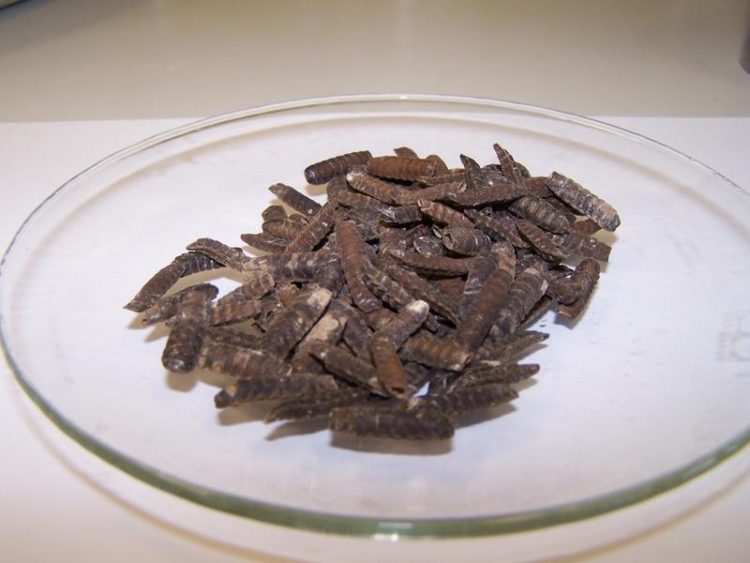Insects supply chitin as a raw material for the textile industry

After pupae shed their skin, pupal exuviae remain as residual stream. Fraunhofer IGB
Chitin is a major component of insect skins and shells; large quantities of it result from the production of animal feed – ever since the feed industry has increasingly relied on insects as protein suppliers. Insects have the advantage that they reproduce quickly and can be bred cheaply on low-value substrates.
This makes them a sustainable source of protein. So far, soya has been used for this purpose, but its cultivation is in direct competition with food production. Insect proteins have already been approved for poultry and pig feed. Since summer 2017, they can also be used as feeding stuff for fish. It is therefore to be expected that the use of insect proteins will become even more important in the future.
Insects supply feed proteins – the waste product chitin is as a valuable recyclable material
The feed industry is focused on proteins, but the skins and shells of insects remain as a waste product. If they can also be utilized, this contributes to the sustainability and economic efficiency of the overall feed production. The potential is enormous: in the course of their development, the larvae of the insects shed their skins several times. The remaining molting products consist up to 40 percent of chitin.
In the joint project “ChitoTex”, the Fraunhofer Institute for Interfacial Engineering and Biotechnology IGB is investigating how insect chitin from animal feed production can be processed to supply biobased chemicals for textile processing.
“For a long time now, we have been working on the development of processes for the recycling of residual and waste materials and therefore have the necessary expertise,” explains Dr. Susanne Zibek, who heads the research area of industrial biotechnology at the Institute.
Biopolymer chitosan as a substitute for environmentally harmful fluorocarbons
At first, the Fraunhofer researchers have developed a purification process to separate chitin from further components of the insect skins such as proteins and minerals. “We are investigating various ways of deacetylating chitin to produce chitosan,” Zibek explains. “With an enzyme screening for example, we search for suitable enzymes for the deacetylation process”.
Due to its ability to form films, chitosan can be used as a sizing agent. This reduces friction in weaving machines and prevents the roughening or breaking of yarns in the weaving process; after that the sizing agent is either washed out again or remains on the yarn. In either case, biobased and natural alternatives to synthetic agents are beneficial for man and environment.
The second possible application is the functionalization of textiles, i.e. the finishing of textile fabrics with specific properties. “For example, we want to use the functional amino group to link hydrophobic molecules with the chitosan. Water-repellent properties can be achieved when applied to textiles.” Until now, environmentally harmful fluorocarbons are widely used for the hydrophobic finishing of outdoor textiles.
Presentation at the ACHEMA
At the ACHEMA from June 11–15, 2018 in Frankfurt am Main, Fraunhofer IGB will be available for further information and discussions at the Fraunhofer joint stand in Hall 9.2, Booth D66.
https://www.igb.fraunhofer.de/en/press-media/press-releases/2018/insects-supply-…
Media Contact
All latest news from the category: Trade Fair News
Newest articles

Superradiant atoms could push the boundaries of how precisely time can be measured
Superradiant atoms can help us measure time more precisely than ever. In a new study, researchers from the University of Copenhagen present a new method for measuring the time interval,…

Ion thermoelectric conversion devices for near room temperature
The electrode sheet of the thermoelectric device consists of ionic hydrogel, which is sandwiched between the electrodes to form, and the Prussian blue on the electrode undergoes a redox reaction…

Zap Energy achieves 37-million-degree temperatures in a compact device
New publication reports record electron temperatures for a small-scale, sheared-flow-stabilized Z-pinch fusion device. In the nine decades since humans first produced fusion reactions, only a few fusion technologies have demonstrated…





















